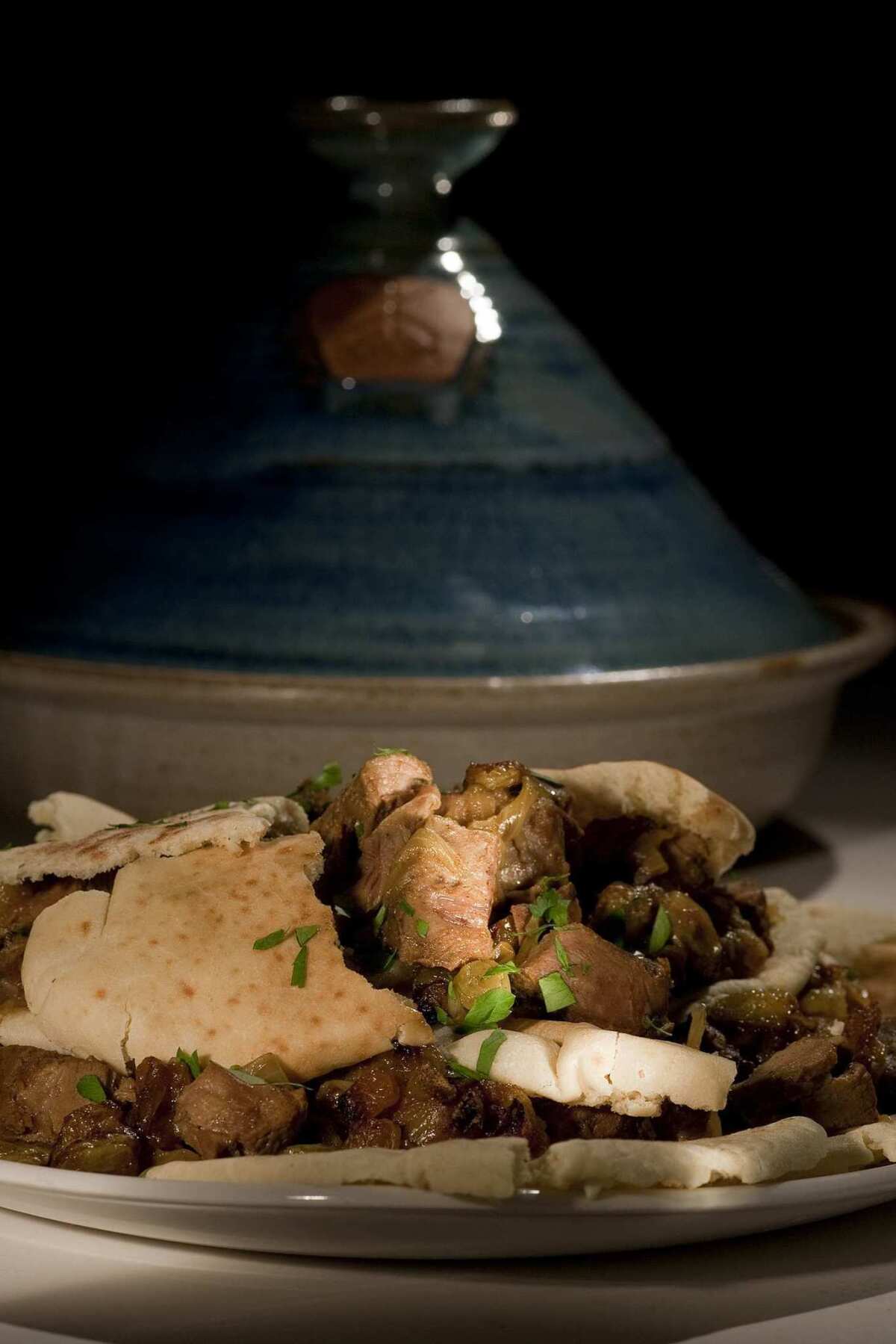Recipe: Lamb tagine with layered onions

I’ve always done my armchair traveling through cookbooks — whether it’s Elizabeth David’s Mediterranean, Fuschia Dunlop’s Sichuan or Claudia Roden’s Middle East. My copy of Paula Wolfert’s original “Couscous & Other Good Food From Morocco”is stained and worn, with notes scribbled in the margins, marks of so many dinner parties through the years.
But so much changed since Wolfert published that book in 1973. Just think in terms of ingredients available now, such as argan oil, Moroccan cumin or real saffron. Her publisher urged her to revise the book, but Wolfert doesn’t do anything by halves. She ended up rewriting and expanding it to more than 500 pages. In the process most recipes were tweaked, dozens more added and the book was renamed “The Food of Morocco.”
I loved every dish, every tip and trick she offered. I actually made warka, the thin pastry leaves for a proper bestila (most people substitute filo) following a new and brilliantly easy technique she learned on Arabic YouTube. Basically, you paint the batter onto a nonstick skillet and when edges begin to curl, pick up the thin, transparent pastry leaf. And do it again. And again. The bestila itself is magnificent, especially the more savory Tétouan-style, brightened with preserved lemon.
I went into a frenzy of bread baking, turning out Marrakech tagine bread, Moroccan country bread, Middle Atlas flat bread and Tangier street bread on a daily basis. I still haven’t located the super-fine semolina required for msemmen pancakes fried on a griddle and served with honey and butter, but that’s next.
There are recipes for marvelous chicken and beef and lamb tagines — with prunes, with quince, with preserved lemon and green olives or smothered in tomato jam. And now that we have more real butchers in town, you should be able to find cuts like lamb shoulder more easily. She’s got a brilliant array of those little cooked salads, too. And cookies, such as her double-baked anise ones to dip in tea and her impossibly delicious, crumbly semolina almond cookies, that I’ll keep in my repertoire forever.
“The Foods of Morocco” by Paula Wolfert, Ecco Press, $45
— S. Irene Virbila
Lamb tagine with layered onions
Total time: About 3 hours, plus cooling times
Servings: 6
Note: Adapted from “The Food of Morocco” by Paula Wolfert. She writes, “This is the Fes version of a famous layered onion tagine called qamamma. I love the way the onions are cooked down to a melting unctuous sauce then combined with tomatoes or raisins and/or honey. With my recipe you do most of the work 1 or 2 days in advance. Then on the day you serve it, you assemble and bake the dish, then switch the oven to broil, dribble over some olive oil, and cook until the onions turn crusty and lightly charred.” Cubeb pepper is available online; additional white and/or black pepper can be substituted.
La Kama spice mixture
1 teaspoon ground ginger
1 teaspoon ground turmeric
1 teaspoon freshly ground white pepper
1/2 teaspoon ground cinnamon
1/2 teaspoon cubeb pepper (optional)
A good pinch of grated nutmeg
Mix the ground spices. Sift through a fine sieve and store in a closed jar in a cool, dark place. This makes a generous tablespoon of the spice mixture.
Saffron water
1/2 teaspoon crumbled saffron strands
1 cup hot water
In a warm (not hot) skillet, dry the saffron strands. Crush again, then soak in the hot water and store in a small jar in the refrigerator. This will keep for up to a week.
For longer storage (my favorite method), quadruple the recipe quantities above: pour the saffron water into a plastic ice cube tray and freeze into cubes. Once they are frozen, shake out the cubes and store in a freezer bag. Each cube will be equivalent to 2 tablespoons saffron water or a good pinch of dried saffron threads.
Tagine and assembly
3 pounds thick lamb shoulder arm chops, bone-in, cut into 9 or 10 pieces
Coarse salt
1 tablespoon La Kama Spice Mixture
2 tablespoons Saffron Water
1 tablespoon liquid honey, preferably a floral honey such as orange blossom, lavender or acacia
1 medium red onion, coarsely grated (1/2 cup)
2 tablespoons extra virgin olive oil, divided
2 cups water
2 tablespoons clarified butter, divided
3 pounds onions, cut into 1/4-inch-thick slices
1 (2-inch) cinnamon stick
Freshly ground black pepper
3/4 cup golden raisins, soaked in warm water for 15 minutes and drained
2 tablespoons turbinado or other raw sugar
1 teaspoon ground Ceylon cinnamon
3 pita or Indian naan breads
1 tablespoon chopped parsley for garnish
1. One or 2 days before you plan to serve, trim the lamb of excess fat. Place the meat in a medium flameproof casserole and add 1 teaspoon salt, the spice mixture, saffron water, honey, grated onion and 1 tablespoon of the oil. Stir over low heat until the aroma of the spices is released, about 5 minutes: Do not brown the meat. Add the water, bring to a boil, and reduce the heat to low, cover and cook for 2 1/2 hours, or until the meat is almost falling off the bone.
2. Separate the cooking juices and the meat. When the meat is cool enough to handle, pull out and discard the bones and trim off any fat or gristle. Cut the meat into 1-inch chunks and transfer to a storage bowl; you should have about 4 cups of meat. Degrease the cooking juices. Return the cooking juices to the casserole and boil down to a glaze. Add one-half teaspoon salt, 1 tablespoon of the butter, the sliced onions and cinnamon stick; cover and cook, stirring occasionally, until the onions are soft and golden, about 45 minutes. Use a slotted spoon to transfer the onions to a storage dish. Discard the cinnamon stick. Boil down the liquid in the casserole to about three-fourths cup. Season with salt and pepper and remove from the heat, then add the liquid to the meat. Up to this point the recipe can be prepared up to 2 days in advance. Cool, cover and refrigerate the meat and onions.
3. About an hour before serving, set an oven rack on the middle shelf of the oven. Heat the oven to 350 degrees.
4. Grease an ovenproof tagine or shallow baking serving dish with remaining butter. Spread the meat on the bottom and cover with the cooked onions and raisins. Scatter the sugar and ground cinnamon on top. Place in the oven and bake, uncovered, for 40 minutes. Switch the oven heat to broil, dribble over the remaining tablespoon of oil, and cook until crusty and lightly charred, about 5 minutes.
5. Reheat the bread in the oven for a few minutes. Split in half, then tear each half into 2 or 3 pieces. Spread about one third over a large serving platter. Spoon about half of the contents of the tagine on top. Repeat with another third of the bread and the remaining contents of the tagine. Top with the last pieces of the bread and a sprinkling of parsley and serve at once.
Each serving: 705 calories; 40 grams protein; 60 grams carbohydrates; 6 grams fiber; 34 grams fat; 14 grams saturated fat; 138 mg cholesterol; 27 grams sugar; 860 mg sodium.
More to Read
Eat your way across L.A.
Get our weekly Tasting Notes newsletter for reviews, news and more.
You may occasionally receive promotional content from the Los Angeles Times.






